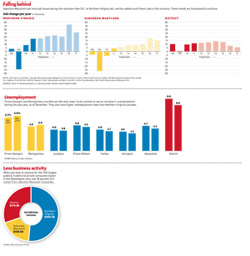Left behind: Maryland’s jobless recovery
Government policicies and even geography are keeping the Old Line State from reaping the recovery’s rewards. As Northern Virginia leaps ahead in growth, Maryland confronts reputation for not being business friendly.
By Bryant Ruiz Switzky, senior staff reporter
To casual observers, the economic recovery probably seems to be playing out pretty evenly across Greater Washington. Bethesda has a bustle similar to Ballston’s, and downtown Silver Spring hums with activity just as Springfield does.
 But look at the number of jobs created across the region in recent years and a lopsided picture emerges: Suburban Maryland is lagging far behind Northern Virginia and D.C. Making matters worse, Maryland’s suburbs lost more jobs during the recession, so they had a deeper hole to climb out of.
But look at the number of jobs created across the region in recent years and a lopsided picture emerges: Suburban Maryland is lagging far behind Northern Virginia and D.C. Making matters worse, Maryland’s suburbs lost more jobs during the recession, so they had a deeper hole to climb out of.
From 2010 to 2012, suburban Maryland — including Montgomery, Prince George’s, Frederick, Calvert and Charles counties — saw a net gain of 4,300 jobs. At the same time, Northern Virginia added 44,100 jobs and D.C. added 32,500 jobs.
So far, it’s been a jobless recovery for the Old Line State.
Economists point to two main culprits: Companies are choosing to move to or expand in Northern Virginia rather than in suburban Maryland, and the sectors showing the most job growth are weaker in suburban Maryland than the rest of the region.
It’s no secret that Maryland has traditionally been less business friendly than its neighbor across the Potomac, but the job growth figures underscore just how much that plays into the everyday lives of residents there as the region’s economy recovers from the Great Recession.
If Montgomery and Prince George’s counties aren’t living up to their economic potential, it squeezes county and state government coffers, which can mean less money for an assortment of needs, such as roads, schools and economic development.
From a business-choice perspective, a lot of it comes down to statewide policy and priorities, said Richard Clinch, an economist with the Jacob France Institute at the University of Baltimore and a longtime chronicler of economic trends in Maryland.
“Maryland has a higher cost of doing business, higher taxes and higher regulatory burdens than Virginia,” he said.
The major corporate relocations of recent years –— Hilton Worldwide Inc., Northrop Grumman Corp. and Volkswagen of America Inc. -— have all gone to Northern Virginia.
Simple geographic assets also play a part. While Montgomery County has become a hub of biotech activity, centered on the National Institutes of Health, the job growth in that sector has paled in comparison to the defense contracting boom of the last two decades emanating from the Pentagon in Northern Virginia.
On top of that, Northern Virginia has two major airports, and parts of Virginia are much closer to downtown D.C. than Maryland is. Virginia is also a right-to-work state, which gives labor unions less clout.
“As a result, we ended up with a whole heck of a lot more jobs being added in Northern Virginia over the last 20 years than in suburban Maryland,” said economist Stephen Fuller, director of the Center for Regional Analysis at George Mason University.
That long-term trend was magnified by the recession, making it harder for suburban Maryland to bounce back.
When it comes to particular sectors where Maryland has been lackluster, economist Greg Liesch at Delta Associates points to health and education. That was the fastest growing sector in Greater Washington in 2012, adding 13,000 jobs. But suburban Maryland accounted for just 3,000 of them.
The next biggest job growth sector last year was state and local government, which added 12,000 jobs. But only 2,000 of those were in suburban Maryland.
The largest area of growth for suburban Maryland in 2012 was “professional and business services,” a broad category that can be hard to pin down but includes most government contractors.
Suburban Maryland saw an 8,000-strong surge in that sector in 2012, accounting for almost two-thirds of the jobs created. Fuller said he hasn’t been able to figure out just what’s behind that burst of activity.
But beware, “by sector” job numbers are a little different from the total annual job numbers cited earlier in this story. The “by sector” figures represent a month-over-year change in jobs from December 2011 to December 2012 and are not seasonally adjusted.
The annual numbers, on the other hand, are seasonally adjusted by the U.S. Bureau of Labor Statistics and account for jobs lost and created throughout the year, not just the change from one December to the next.
However you slice it, the trend of suburban Maryland adding fewer jobs than its neighbors isn’t about to go away.
D.C. is projected to add more jobs than suburban Maryland in each of the next three years (even though it only has a quarter of the population), and Northern Virginia is projected to add more than twice as many jobs as the Maryland suburbs get each year until 2017, when that gap narrows a bit, according to forecasts from the Center for Regional Analysis. Liesch said his forecasts are similar.
At a state level, the Maryland Department of Business & Economic Development can’t do much about taxes and regulation, but spokeswoman Karen Hood pointed to initiatives aimed at spurring more business growth.
The Invest Maryland program, for example, will dole out $84 million in the coming years to early-stage tech companies.
“Montgomery County has seen a number of investments through this program,” Hood said. “We hope to see a lot more because they obviously have a lot of activity going on in their backyard. We feel there’s some tremendous potential for job creation.”
Prince George’s County isn’t shy about the need for reforms.
“The county needs to take extraordinary efforts to catch up to our neighbors,” said David Iannucci a county economic development official.
He points to a slew of initiatives by County Executive Rushern Baker to make Prince George’s a better place to do business, including a $50 million economic development incentive fund, regulatory reforms, dropping the crime rate, improving the education system and partnering with some of the large institutions in the county, including the University of Maryland and NASA’s Goddard Space Flight Center.
“We’re coming off a history of lagging our neighbors, but things are clearly turning around,” he said.
Montgomery County economic development officials are much less candid about the jurisdiction’s challenges. While no one in the office was available for an extensive interview, Sally Sternbach, deputy director of economic development, challenged the premise that Montgomery County has lagged Northern Virginia, pointing to the county’s strength in high-tech.
“We’re the only local jurisdiction in the U.S. with a biotech tax credit,” she wrote in an email, adding that the county is working with the National Institutes of Standards and Technology on a National Cybersecurity Center of Excellence. The 1-year-old center aims to make Maryland the nexus of cybersecurity jobs and training.
In addition, Montgomery County created a small business ombudsman to help companies navigate the regulatory bureaucracy.
“We play second to none,” she wrote.
Bryant Ruiz Switzky
Senior reporter: Banking, finance and corporate accountability
Washington Business Journal
